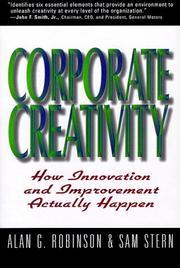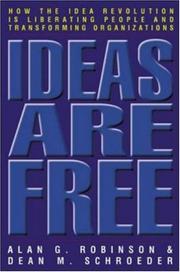| Listing 1 - 7 of 7 |
Sort by
|
Book
ISBN: 9789046509005 Year: 2007 Volume: 30 Publisher: Mechelen Kluwer
Abstract | Keywords | Export | Availability | Bookmark
 Loading...
Loading...Choose an application
- Reference Manager
- EndNote
- RefWorks (Direct export to RefWorks)
Voor talloze bedrijfsprocessen geldt dat de beste deskundigen van die processen de eerstelijnsmedewerkers zijn. Toch wordt er vaak onzorgvuldig omgegaan met de ideeën van de werkvloer. Daarmee worden kansvolle mogelijkheden voor kwaliteitsverbetering of efficiencyvergroting niet benut. Zonder een goed ideeënmanagementsysteem (IMS), een instrument waarmee de ideeën van alle werknemers worden verzameld, is het onmogelijk om tot verbeteringen te komen. De auteurs zetten uiteen hoe een IMS medewerkers stimuleert om hun ideeën naar voren te brengen en managers aanmoedigt de ideeën serieus te nemen en, als het een geschikt idee betreft, te implementeren. Aan de hand van praktijkvoorbeelden uit 8 Europese landen laten ze zien dat een goed IMS van doorslaggevend belang is voor duurzame productviteit, kwaliteit en groei. Het is tevens de pijler onder het innovatiemanagement, aangezien het leidt tot meer en creatievere innovatieve projecten die met succes worden bekroond. Het werk bestaat niet alleen uit theorie en praktijkvoorbeelden, er is ook een checklist opgenomen waarmee bedrijven de kwaliteit van hun eigen ideeënmanagement kunnen beoorden. Ten slotte is een hoofdstuk gewijd aan de antwoorden op veelgestelde vragen (FAQ)
Economic production --- creativiteit --- innovatiemanagement --- Personnel management --- personeelsmanagement --- Innovatie --- Veranderingsmanagement --- Kwaliteit --- Integrale kwaliteitszorg --- Personeelsmanagement --- Effectiviteit --- Organisatieleer --- Werknemers --- Participatie --- 65.012.4 --- 338.9 --- Créativité Creativiteit --- #KVHB:Arbeids- en organisatiepsychologie --- #KVHB:Management --- #KVHB:Innovatie --- arbeid, motivatie --- human resources management --- S2007348.JPG --- personeelsbeleid --- reorganisatie van organisaties --- management - leidinggeven (zie ook 361.012) --- bedrijfsleven, diverse vraagstukken (zie ook 65) --- 658.3 --- 65.012 --- Kwaliteit (proceskenmerk) --- Werknemer --- Inspraak

ISBN: 1605097616 1583763031 0585266484 9780585266480 9781605097619 1576750094 1576750493 Year: 1997 Publisher: San Francisco Berrett-Koehler
Abstract | Keywords | Export | Availability | Bookmark
 Loading...
Loading...Choose an application
- Reference Manager
- EndNote
- RefWorks (Direct export to RefWorks)
Alan Robinson and Sam Stern have investigated hundreds of creative acts that have occurred in organizations around the world to find the truth about how innovation and improvement really happen. Rich with detailed examples, Corporate Creativity identifies six essential elements that companies can use to turn their creativity from a hit-or-miss proposition into something consistent that they can count on.
Creative ability in business. --- Technological innovations --- Organizational learning. --- Learning organizations --- Learning --- Communities of practice --- Knowledge management --- Business creativity --- Business --- Success in business --- Management. --- Creative ability in business --- Organizational learning --- 658.305 --- AA / International- internationaal --- Management --- Aansporingen en voorstellen tot arbeid --- Organization theory
Book
ISBN: 2708124854 Year: 2000 Publisher: Paris : Les Editions d'Organisation,
Abstract | Keywords | Export | Availability | Bookmark
 Loading...
Loading...Choose an application
- Reference Manager
- EndNote
- RefWorks (Direct export to RefWorks)

ISBN: 1576753743 9786612300004 1282300008 1605090174 9781605090177 9781609943578 1609943570 1576752828 9781576752821 9781576753743 9781605090085 1605090085 9781609944599 1609944593 9781605090078 1605090077 1282298968 9781282298965 9786612298967 6612298960 Year: 2006 Publisher: San Francisco : Berrett-Koehler,
Abstract | Keywords | Export | Availability | Bookmark
 Loading...
Loading...Choose an application
- Reference Manager
- EndNote
- RefWorks (Direct export to RefWorks)
The fact is, because they're the ones actually doing the day-to-day work front-line employees see a great many problems and opportunities that their managers don't. But most organizations do very poorly at tapping into this extraordinary potential source of revenue-enhancing, savings-generating ideas.Ideas Are Free sets out a roadmap for totally integrating ideas and idea management into the way companies are structured and operate. Alan Robinson and Dean Schroeder draw on their ten years experience with more than three hundred organizations in fifteen countries to show precisely how to design
Corporate culture. --- Management. --- Organizational change. --- Organizational effectiveness. --- Suggestion systems. --- Management --- Employee participation. --- Employee suggestions --- Change, Organizational --- Organization development --- Organizational development --- Organizational innovation --- Autogestion (Employee self-management) --- Codetermination, Worker --- Consultative management --- Economic democracy --- Employee involvement in management --- Employee participation in management --- Employees' representation in management --- Industrial democracy --- Labor participation in management --- Participative management --- Participatory management --- Self-management by employees --- Worker codetermination --- Worker participation in management --- Worker self-management --- Workers' control --- Workers' participation in management --- Workers' self-management --- Culture, Corporate --- Institutional culture --- Organizational culture --- Incentives in industry --- Organization --- Manpower planning --- Industrial relations --- Employee ownership --- Producer cooperatives --- Corporations --- Organizational behavior --- Business anthropology --- Sociological aspects --- Corporate culture --- Organizational change --- Organizational effectiveness --- Suggestion systems --- #SBIB:309H251 --- #SBIB:316.334.2A553 --- Employee participation --- Interne communicatie en organisatie --- Personeelsbeleid en loonbeleid, functieclassificaties
Book
ISBN: 9782212538908 Year: 2007 Publisher: Paris Editions d'Organisation
Abstract | Keywords | Export | Availability | Bookmark
 Loading...
Loading...Choose an application
- Reference Manager
- EndNote
- RefWorks (Direct export to RefWorks)
Book
ISBN: 9781626561236 Year: 2014 Publisher: San Francisco Berrett-Koehler Publishers
Abstract | Keywords | Export | Availability | Bookmark
 Loading...
Loading...Choose an application
- Reference Manager
- EndNote
- RefWorks (Direct export to RefWorks)
Book
ISBN: 1523001798 Year: 2022 Publisher: Berrett-Koehler Publishers, Inc.
Abstract | Keywords | Export | Availability | Bookmark
 Loading...
Loading...Choose an application
- Reference Manager
- EndNote
- RefWorks (Direct export to RefWorks)
This book is a comprehensive guide to an exciting new approach that managers at any level can use to transform their corners of government.Whether people want more government or less, everyone wants an efficient government. Traditional thinking is that this requires a government to be run more like a business. But a government is not a business, and this approach merely replaces old problems with new ones.In their six-year, five-country study of seventy-seven government organizations-ranging from small departments to entire states-Alan Robinson and Dean Schroeder found that the predominant private-sector approaches to improvement don't work well in the public sector, while practices that are rare in the private sector prove highly effective. The highest performers they studied had attained levels of efficiency that rivaled the best private-sector companies.Rather than management making the improvements, as is the norm in the private sector, these high-performers focused on front-line-driven improvement, where most of the change activity was led by supervisors and low-level managers who unleashed the creativity and ideas of their employees to improve their operations bit by bit every day.You'll discover how Denver's Department of Excise and Licenses reduced wait times from an hour and forty minutes to just seven minutes; how the Washington State Patrol garage tripled its productivity and became a national benchmark; how a K8 school in New Brunswick, Canada, boosted the percentage of students reading at the appropriate age level from 22 percent to 78 percent; and much more.
| Listing 1 - 7 of 7 |
Sort by
|

 Search
Search Feedback
Feedback About UniCat
About UniCat  Help
Help News
News